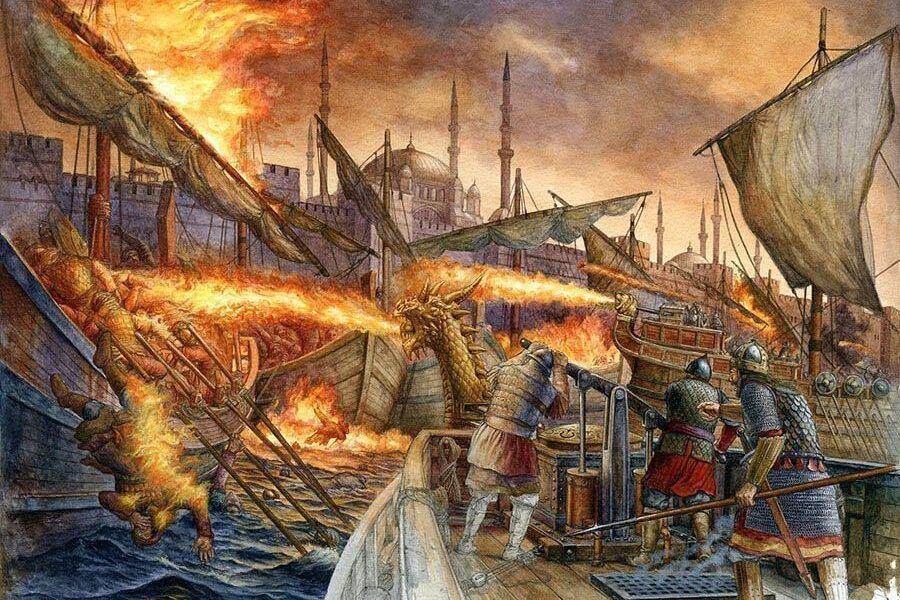“Greek fire” has become infamous as a mysterious East Roman (Byzantine) incendiary weapon that helped the empire survive against many invasion attempts.
The formula remains a mystery even for scientists today, but it certainly helped the Greek-speaking East Roman keep the enemy away from their vast lands which once spanned Southern Europe, North Africa, the Black Sea and Asia Minor.
More importantly, the Greek fire saved Constantinople, the seat of the Byzantine Empire, from repeated sieges by the Arabs.

Even when it was captured, enemies of Byzantium were never able to recreate the unique chemical concoction that generated fire that was capable of slicing through water.
Invention of Greek fire
Greek fire — as the Crusaders referred to it — was also called “liquid fire,” “Roman fire,” or “sea fire.” It was not the first incendiary weapon used in battle. Yet, historically, it is significant for its power.
It was created in the seventh century, most likely the invention of Kallinikos of Heliopolis, a Jewish architect who fled from Syria to Constantinople.
When the Byzantines were being attacked by the forces of Muhammad, the founder of Islam, and parts of Syria had been taken over, Kallinikos experimented with a variety of materials until he discovered a mix for an incendiary weapon.
Kallinikos sent the formula to the Byzantine emperor, and authorities developed a siphon that operated somewhat like a syringe, propelling the fiery concoction toward enemy ships.
Weapon of destruction
Greek fire was mainly used to set enemy ships on fire from a safe distance. Its ability to remain lit in water for a certain amount of time was its unique power as it prevented the enemy from dousing the flames during maritime battles.
It is said that the mysterious Byzantine weapon produced a loud roar and lots of smoke, and it was so effective that the enemy was terrorized and often fled at the sight of it.
Historical records say that Greek fire stuck to whatever whatever surface it touched. Amazingly, it could only be extinguished with a mixture of vinegar, sand, and old urine.
It seems that the invention of Kallinikos served its purpose as it was effective in repelling the enemy fleet and ending the First Arab Siege of Constantinople in 678 AD.
It was similarly successful during the Second Arab Siege of Constantinople (717-718 AD), again causing massive damage to the Arab navy.

The new weapon of mass destruction was so powerful indeed that the Byzantines kept its composition a well-guarded secret.
The Kallinikos family and the Byzantine emperors were the only ones with knowledge of its secret formula, which was passed down from generation to generation.
The formula was so well-guarded that even when enemies of the empire literally got their hands on Greek fire, they could not reproduce it.
Sulfur, pine resin, quicklime, and petrol were suggested as ingredients, but no actual recreation of Greek fire was ever achieved.
There are historical records of Arabs using their version of Greek fire against Crusaders during the Seventh Crusade in the 13th century.
Ultimately, the secret of its lethal recipe was lost to history.
Greek fire
Hand-siphon launching Greek fire, like a modern-day flamethrower.
The Byzantines continued to use the puzzling weapon for centuries, and its use was not limited to naval battles.
The incendiary weapon was used in several ways on both sea and land. It was used not only to burn down siege towers but also against enemy fortifications.
There was a hand-held version of the weapon called the cheirosiphon which was something like an ancient version of a flamethrower.
Furthermore, the Byzantines used to fill clay jars with Greek fire so they could hurl it at the enemy much like grenades.
Jars of Greek fire and caltrops—spiked metal devices strewn on the ground to impede chariots—that had been doused in the liquid were used as offensive weapons by Byzantine armies.
Arabs, Bulgarians, Russians, and other invaders experienced the power of Greek fire through the centuries, making it an influential military invention.
From the 7th century until the Fall of Constantinople on May 29, 1453, this Byzantine weapon was significant in protecting the Greek empire.
According to some historians, it was Greek fire that had kept the Byzantine Empire protected from invaders for centuries, subsequently saving the whole of Western civilization.
READ MORE: Turks use the Temple of Athena as a gateway for a nightclub.

